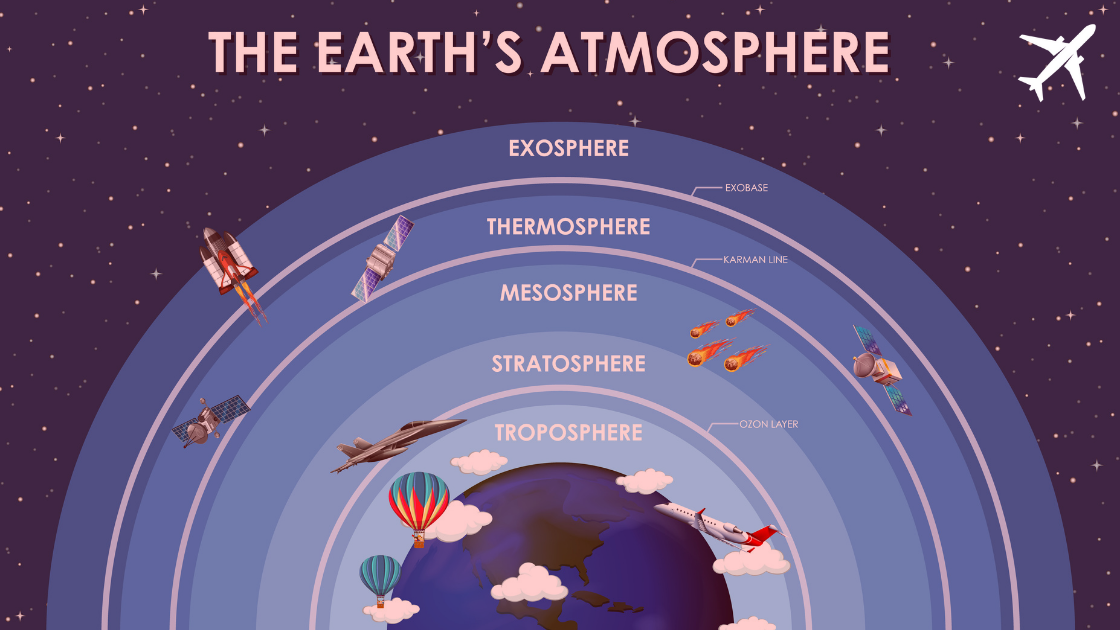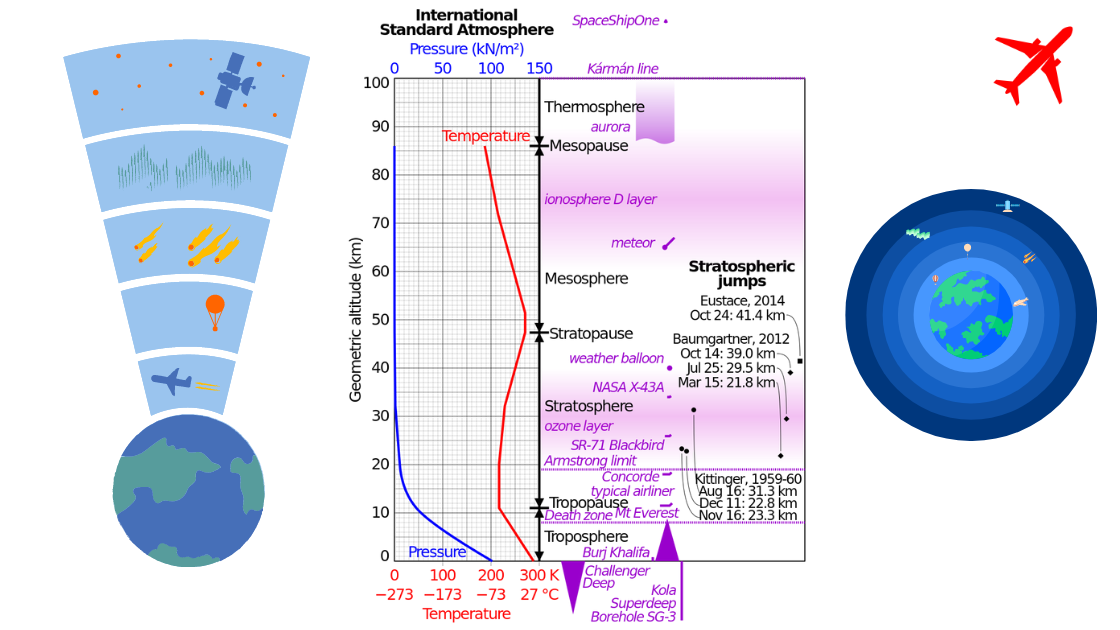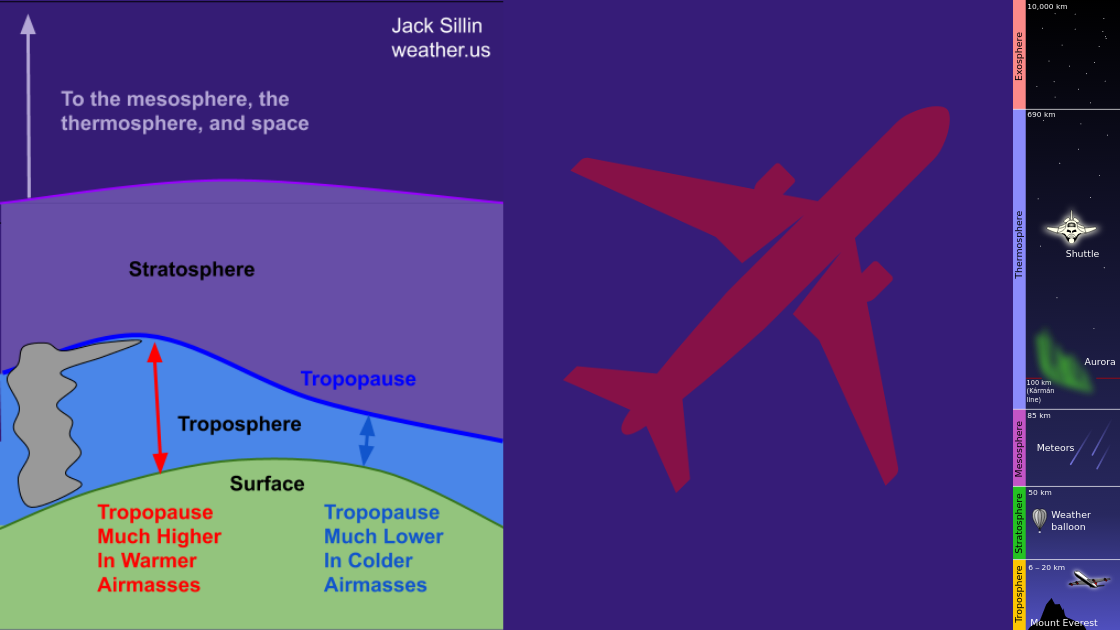Aviation Meteorology: Decoding Atmosphere, Composition & ISA Standards

In our inaugural blog on Aviation Meteorology featured on the AviationX platform, we will be deciphering the atmosphere's composition and the ISA Standards – as indicated by the topic. Our goal is to facilitate aspiring pilots, aviation professionals, and enthusiasts in comprehending this concept thoroughly. It's worth mentioning that we have plans to release more meteorology-focused blogs in the future, aiming to provide our readers with an even more profound understanding of the subject.
Additionally, we are committed to addressing intriguing questions posed by our readers along the way, enhancing our connection and offering solutions to queries that both new and existing readers might encounter on this blog or any of our prior entries.
Answer to above question is, Yes, it's possible to transition from being a cabin crew member to becoming a commercial pilot. Many airlines and flight schools accept candidates with diverse aviation backgrounds. However, specific requirements and training will vary depending on the aviation authority and the flight school you choose.
It's recommended to research the qualifications and training programs available to make an informed decision about pursuing a commercial pilot career(read this blog)
In the world of aviation, understanding the Earth's atmosphere is not only crucial but also fascinating. Aspiring pilots need to grasp the intricate composition and thermal characteristics of the atmosphere to navigate safely and effectively through the skies.
This blog get into details of the atmosphere's composition, unraveling the complex mixture of gases that envelop our planet, ISA standards, and much more.
Let's get started

Characteristics and the Enveloping Nature of Atmosphere
The atmosphere is a dynamic, three-dimensional expanse that extends from the Earth's surface to the edge of space. While its total mass encompasses the entire planet, the majority of its gases are concentrated within the lower layers, where weather, climate, and aviation activities take place.
Unraveling the Composition
The atmosphere's composition is a symphony of gases, each playing a unique role in maintaining the equilibrium of the planet.
Let's explore the key constituents:
- Nitrogen (N2): This unassuming gas dominates the atmosphere, comprising a whopping 78.08%. Despite its inert nature, nitrogen is vital for the growth of plants and the structure of biomolecules.
- Oxygen (O2): Following nitrogen, oxygen contributes 20.95% of the atmosphere. It's a cornerstone of respiration and combustion, sustaining life as we know it.
- Argon (Ar): Present in a concentration of 0.93%, argon is chemically inert. Its role is largely thermal, influencing the atmosphere's temperature profile.
- Carbon Dioxide (CO2): Though making up only 0.035% of the atmosphere, the significance of carbon dioxide cannot be overstated. It plays a critical role in the greenhouse effect, impacting the planet's temperature and climate.
The Nuances of Trace Gases
Beyond the major constituents, the atmosphere hosts a medley of trace gases that exert outsized influences:
- Neon (Ne) and Helium (He): While these noble gases are relatively scarce, they contribute to the intricate chemistry of the atmosphere. Helium, in particular, is known for its buoyancy and is used in various applications, including aviation.
- Methane (CH4): This potent greenhouse gas, present in small amounts, plays a significant role in global warming due to its high heat-trapping potential.
- Krypton (Kr): Like other noble gases, krypton contributes to the atmosphere's thermal properties. It's involved in spectroscopy and lighting applications.
- Nitrous Oxide (N2O): Another greenhouse gas, albeit less prevalent, nitrous oxide plays a role in both atmospheric chemistry and climate change.
- Hydrogen (H2): While hydrogen is sparse in the atmosphere, its presence is notable in various chemical reactions.
- Ozone (O3): Scattered in the atmosphere, ozone forms a protective layer in the stratosphere, absorbing harmful UV radiation and preventing it from reaching the surface.
Vertical Distribution and Layers

The atmosphere isn't a uniform mass; it's divided into distinct layers based on temperature and altitude:
- Troposphere: Spanning from the Earth's surface to about 16 kilometers (varies with latitude), this layer is where weather phenomena occur. Temperatures decrease with altitude, creating the conditions for cloud formation and precipitation.
- Tropopause: Acting as a transition between the troposphere and the stratosphere, the tropopause marks a point of change in temperature lapse rate.
- Stratosphere: Above the tropopause, the stratosphere's temperature increases with altitude due to the absorption of UV radiation by ozone.
- Mesosphere: Beyond the stratosphere, temperatures decline again, reaching their lowest values in this layer.
- Thermosphere: Extending to the outermost atmosphere, this region experiences an increase in temperature due to solar radiation absorption.
Simplified Interactive Table Below
Troposphere: Weather and Dynamics
The troposphere is the layer of the atmosphere closest to the Earth's surface, extending from the ground up to approximately 16 kilometers at the Equator, with variations based on latitude. This region is where most of our daily weather phenomena occur, making it of paramount importance for aviation pilots.
One of the defining characteristics of the troposphere is its decrease in temperature with increasing altitude. This temperature decline, known as the "lapse rate," is roughly 6.5°C per kilometer on average.
As a pilot ascends through the troposphere, they encounter cooler and cooler conditions, which has significant implications for aircraft performance and flight planning.
Cloud formation and precipitation processes are driven by the conditions within the troposphere. The decreasing temperatures cause water vapor to condense into visible clouds, and further cooling can lead to precipitation in the form of rain, snow, or hail.
These processes can directly affect visibility, turbulence, and wind patterns experienced during flight.
Tropopause: Transition and Significance
The tropopause acts as the boundary between the troposphere and the stratosphere. It marks a distinct point of change in the temperature lapse rate. While the troposphere experiences decreasing temperatures with altitude, the tropopause introduces a transition to a region where the temperature remains relatively constant, or even increases, with increasing altitude.
For aviation pilots, the tropopause is more than a theoretical transition. It has practical implications for flight planning and performance. Aircraft flying at high altitudes encounter the tropopause, and understanding its characteristics helps pilots anticipate changes in temperature, pressure, and wind patterns as they transition into the stratosphere.
Stratosphere: Ozone and Temperature Rise
Above the tropopause lies the stratosphere, a layer where the temperature increases with altitude. This intriguing phenomenon is primarily attributed to the presence of ozone molecules. These molecules absorb high-energy UV radiation from the sun, converting it into heat energy. This process, known as the ozone-oxygen cycle, warms the surrounding air.
The stratosphere's temperature rise is crucial for aviation because it affects the altitude at which commercial aircraft typically cruise. Flying in the stratosphere reduces fuel consumption and enhances efficiency due to decreased air resistance and more stable atmospheric conditions. The stratosphere's temperature profile also has a protective effect, as it prevents harmful UV radiation from reaching the Earth's surface.

Mesosphere: Cooling to Extreme Lows
Beyond the stratosphere lies the mesosphere, a layer where temperatures once again decline with altitude. This cooling trend continues until the lowest temperatures in the atmosphere are reached in the mesosphere. While temperature variations in the mesosphere are not as prominent as in the troposphere and stratosphere, they still play a role in atmospheric dynamics.
The mesosphere is known for phenomena like noctilucent clouds, which form at extremely high altitudes and are illuminated by the sun even after it has set at ground level. These clouds are a visual manifestation of complex interactions between atmospheric particles and solar radiation.

More About Noctilucent Clouds(Click Here)
Noctilucent clouds, also known as polar mesospheric clouds, are a fascinating and relatively rare meteorological phenomenon that occurs in the Earth's mesosphere, at altitudes of around 76 to 85 kilometers (47 to 53 miles) above the surface. These clouds are unique not only because of their high altitude but also due to their mesmerizing appearance and behavior. Here's a detailed explanation of noctilucent clouds:
Formation and Composition: Noctilucent clouds are composed of tiny ice crystals that form around dust and meteoric particles in the upper atmosphere. Their formation is attributed to the presence of water vapor at these extreme altitudes, where temperatures can plummet to as low as -120°C (-184°F). Despite these frigid temperatures, the ice crystals can persist due to the lack of liquid water, which prevents them from sublimating directly into vapor.
Appearance and Characteristics: Noctilucent clouds are known for their stunning appearance, often resembling thin, wispy, silvery-blue clouds that glow against the dark night sky. The term "noctilucent" itself means "night-shining," which accurately describes their luminous quality. These clouds are usually visible during the twilight hours, shortly after sunset or before sunrise, when the Sun is below the horizon but still illuminates the upper atmosphere.
Seasonal Occurrence: Noctilucent clouds are most commonly observed during the summer months in the Earth's polar regions, both in the northern and southern hemispheres. This is because the mesosphere becomes coldest during these seasons, providing the ideal conditions for ice crystal formation. They are typically seen at latitudes between 50° and 70°, where the Sun's light can still reach their altitude despite being below the horizon.
Role of Sunlight: The unique appearance of noctilucent clouds is due to a combination of factors. The Sun, even though it's not visible from the ground, can still illuminate these high-altitude clouds when it's just below the horizon. The ice crystals in the clouds scatter and reflect this sunlight, creating their characteristic bright appearance against the dark sky.
Scientific Interest: Noctilucent clouds are of significant interest to atmospheric scientists and researchers. They are indicators of the state of the upper atmosphere and can provide insights into processes such as atmospheric circulation patterns, climate change, and the effects of human activity on the environment. Changes in the occurrence, brightness, and distribution of these clouds could potentially reflect alterations in the composition and behavior of the upper atmosphere.
In conclusion, noctilucent clouds are captivating and elusive natural phenomena that offer a glimpse into the intricacies of our planet's upper atmosphere. Observing these night-shining clouds is not only a visual treat for skywatchers but also contributes to our understanding of Earth's atmospheric dynamics.
Just Awesome!
Interesting Fact
Noctilucent clouds are sometimes referred to as "mother of pearl clouds" due to their resemblance to the iridescent luster and delicate colors of pearls found in mother-of-pearl or nacre.
This name draws a poetic analogy between the ethereal beauty of these high-altitude clouds and the shimmering, luminous qualities of pearls with their captivating play of colors.
The term "mother of pearl" is commonly used to describe the inner lining of mollusk shells, particularly oysters and abalones. This material exhibits a remarkable interplay of colors, often displaying shades of iridescent blues, greens, pinks, and purples as light interacts with the microscopic layers of calcium carbonate crystals. These layers refract and reflect light in a way that produces the characteristic shimmering effect.
Similarly, noctilucent clouds exhibit a similar iridescence and luminosity against the dark night sky. When illuminated by the Sun below the horizon, these high-altitude ice crystals scatter and reflect sunlight, creating a mesmerizing display of silvery-blue and iridescent colors. The visual resemblance between the delicate hues of these clouds and the iridescence of pearls led to the poetic association with the term "mother of pearl clouds."
This name captures the enchanting and rare nature of noctilucent clouds, evoking the same sense of wonder and beauty that people often associate with the captivating hues of pearls found in mother-of-pearl shell
Thermosphere: Extreme Temperatures and Ionization
Extending to the outermost limits of the atmosphere, the thermosphere experiences a remarkable increase in temperature with altitude. This rise in temperature is not due to the heating effect of the sun's rays directly but rather to the absorption of intense solar ultraviolet (UV) and X-ray radiation.
Despite the high temperatures, the thermosphere's low density means that it would not feel hot to a human body passing through it. The region's sparse gas molecules have high kinetic energy due to the absorbed solar radiation, but the energy is not efficiently transferred to a solid object, leading to a lack of "feeling" the heat.
In addition to the temperature rise, the thermosphere also houses the ionosphere, a region rich in charged particles (ions) resulting from the high-energy solar radiation.
Understanding the intricate layers of the atmosphere and their thermal characteristics is essential for aviation pilots. It influences flight planning, altitude selection, and safety considerations. Pilots who grasp these dynamics navigate the skies more effectively, ensuring both passenger comfort and flight success.
Here are some interesting fact about the thermosphere(Click)
Temperature Paradox: Despite its name, the thermosphere is characterized by extremely high temperatures, reaching up to thousands of degrees Celsius. However, this doesn't mean that the air in the thermosphere feels hot. In fact, the thermosphere's air is so thin that it has very low density. This means that even though the individual particles in the thermosphere are incredibly hot, they are so sparse that they don't transfer much heat to objects passing through this layer, such as spacecraft. This paradox highlights the distinction between temperature and heat transfer in different layers of the atmosphere.
Auroras and Ionization: One of the most remarkable phenomena associated with the thermosphere is the aurora, also known as the Northern and Southern Lights. These breathtaking displays of colorful lights in the sky occur when charged particles from the Sun, known as solar wind, interact with the gases in the thermosphere. The solar wind's impact on the thermospheric gases causes ionization, which means that electrons are stripped from their atoms, creating charged particles. As these charged particles recombine with the atoms, they release energy in the form of light, leading to the stunning auroras.
Ionosphere and Radio Communication: The lower portion of the thermosphere, known as the ionosphere, plays a crucial role in radio communication. The ionization of gases in this layer allows radio waves to be refracted and reflected, making it possible to transmit radio signals over long distances. This property of the ionosphere is utilized in various applications, including long-distance communication and navigation systems.
International Space Station (ISS) Orbit: The International Space Station orbits within the lower thermosphere. While the thermosphere's extremely low density means that there is minimal heat transfer, the high-energy particles in this layer can still have an impact on spacecraft. The ISS occasionally experiences very slight atmospheric drag due to interactions with thermospheric particles, causing it to gradually lose altitude over time. This phenomenon requires periodic adjustments to maintain the ISS's orbit.
Varied Temperatures: The temperature in the thermosphere can vary significantly depending on solar activity. During periods of high solar activity, the thermosphere can become much hotter due to increased solar radiation and ionization. This variability showcases the dynamic nature of Earth's upper atmosphere and its response to the Sun's influence.
These intriguing facts shed light on the thermosphere's unique characteristics and its impact on both natural phenomena and technological applications, making it a captivating layer to explore in the study of atmospheric science.

Standard Atmospheres: Your Navigational Guides
Two standardized atmospheric models provide crucial reference values for aviation and engineering applications:
International Standard Atmosphere (ISA): This model outlines temperature, pressure, and density profiles at different altitudes. It's the go-to reference for aircraft performance calculations, altimeter calibration, and design considerations
More Detail (Click Here)
The International Standard Atmosphere (ISA) specifies a standard set of atmospheric conditions that serve as a reference for aviation, engineering, and meteorological calculations. These conditions are used to establish consistent values for temperature, pressure, density, and other atmospheric parameters at various altitudes. The ISA provides a baseline for performance predictions, aerodynamic calculations, and altimeter calibration. Here are the detailed specifications of the ISA:
Temperature Profile: The ISA temperature profile assumes a lapse rate of 2 degrees Celsius per 1,000 feet (6.5°C per kilometer) up to a certain altitude. This altitude is defined as the Tropopause. The temperature at sea level (Mean Sea Level or MSL) is set at 15 degrees Celsius (59 degrees Fahrenheit). From there, the temperature decreases at a constant rate of 2°C per 1,000 feet (6.5°C per kilometer) until reaching the Tropopause altitude.
Pressure and Density Profiles: Based on the temperature profile, the ISA establishes corresponding pressure and density values. The pressure at sea level is defined as 1013.25 hectopascals (hPa) or 29.92 inches of mercury (inHg). Pressure decreases with altitude following an exponential decay formula.
The density at sea level is calculated using the sea level pressure and temperature. As altitude increases, the density also decreases, following the same exponential decay as pressure.
Altitude Definitions: The ISA introduces various definitions of altitude:
- True Altitude: The actual height above mean sea level (MSL).
- Indicated Altitude: The altitude indicated by an altimeter when set to a standard pressure (1013.25 hPa or 29.92 inHg). It may differ from true altitude due to local pressure variations.
- Pressure Altitude: The altitude at which the standard pressure of 1013.25 hPa would occur in the atmosphere. It's useful for aircraft operations and altimeter settings.
- Density Altitude: The altitude at which the density of the air corresponds to the ISA density at the current pressure and temperature.
Performance Calculations: The ISA's standardized values serve as the basis for a wide range of aviation calculations, including aircraft performance predictions. Pilots and engineers use these values to calculate takeoff and landing distances, climb rates, fuel consumption, engine performance, and more. By providing consistent reference values, the ISA enables accurate and reliable calculations that aid in flight planning and operations.
It's important to note that the ISA serves as a reference model and does not reflect the actual atmospheric conditions experienced in the real world. Actual atmospheric conditions can deviate from the ISA due to weather patterns, geographic factors, and other variables.
The International Standard Atmosphere (ISA) provides a standardized set of atmospheric specifications that serve as a reference for aviation and engineering calculations. These specifications encompass temperature, pressure, density, and altitude profiles at various altitudes, allowing for accurate and consistent performance predictions and operational planning in the aviation industry.
Jet Standard Atmosphere (JSA): Tailored for high-altitude and spaceflight scenarios, the JSA accommodates variations in temperature lapse rate and other factors.
Mastering the intricacies of the atmosphere's composition equips aspiring aviation pilots with the tools to anticipate and navigate changing conditions with precision. This knowledge isn't just theoretical—it's the bedrock of safe and successful flights.
Key ISA Assumptions in interactive table form below
Their Significance for Pilots

Remember, Both ISA and JSA play critical roles in aviation, each catering to specific atmospheric conditions and flight scenarios.
While ISA is the standard for conventional aviation operations, JSA is essential for pilots and engineers dealing with high-altitude, spaceflight, and extreme conditions. More details below
ISA formula & Calculations
The formula below is employed to calculate the temperature difference as per the International Standard Atmosphere (ISA) guidelines.
ISAT = ST - AT
Where:
- ISAT indicates the temperature difference between the actual temperature (AT) and the standard temperature (ST).
- AT stands for the actual temperature reading in degrees Celsius.
- ST represents the standard temperature corresponding to that altitude. To calculate the ISA temperature, you subtract the actual temperature from the standard temperature.
The standard temperature can be calculated using this formula:
ST = 15 - 1.98 * (A / 1000)
Where ST represents the standard temperature, A signifies the altitude in feet.
An ISA temperature measures the difference between the current temperature reading on an aircraft and the standard temperature set for that altitude.
How to Calculate an ISA Temperature?
Let's go through an illustrative example to understand the steps and information needed for computing an ISA temperature.
Step 1: Determine the actual temperature, which is the temperature noted by the aircraft. In this instance, the actual temperature is -30°C.
Step 2: Find out the altitude of the aircraft. For our example, the altitude stands at 26,000 feet.
Step 3: Compute the standard temperature at that altitude using the mentioned formula
ST = 15 - 1.98 * (26000 / 1000)
ST = 15 - 1.98 * 26.0 ST = -36.48°C
Step 4: Finally, calculate the ISA temperature difference using the provided formula:
ISAT = ST - AT
ISAT = -36.48°C - (-30°C)
ISAT = -6.48°C
Another Example
To calculate the International Standard Atmosphere (ISA) temperature at FL320 (Flight Level 320, which is approximately 32,000 feet), you can use the lapse rate of the ISA model, which is -2°C per 1,000 feet.
Starting with the ISA sea-level standard temperature of 15°C, you can calculate the temperature at FL320 as follows:
Temperature at FL320 = Standard temperature at sea level + (Lapse rate × Altitude in thousands of feet)
Temperature at FL320 = 15°C + (-2°C/1,000 ft × 32)
Temperature at FL320 = 15°C - 64°C
Temperature at FL320 = -49°C
So, the ISA temperature at FL320 would be approximately -49°C.
A Short Story: Captain Alex's Calculated Climb

Meet Alex, an experienced pilot with a passion for overcoming challenges. On a particular day, he's gearing up for a flight that involves climbing to a high altitude. As he prepares, he recollects the significance of comprehending ISA (International Standard Atmosphere) temperature calculations.
Alex takes off, and with each climb, he notices shifts in his aircraft's behavior. He remembers that temperature variations influence engine efficiency and lift – a crucial factor during flight. This is where ISA comes into the picture.
At 10,000 feet, Alex glances at his altimeter, showing an external temperature of -25°C.
Intrigued by the ISA standard, he applies the formula:
ST = 15 - 1.98 * (A / 1000).
By plugging in 10,000 feet, he estimates the standard temperature as -5°C.
Noticing a deviation of 20 degrees, Alex realizes that he's encountering conditions that diverge from the ISA model. The colder air impacts his aircraft's performance differently than what the ISA forecasts.
Continuing his ascent, Alex reaches 20,000 feet. His instrument readings reveal an indicated temperature of -50°C.
Through another calculation, he deduces that the ISA standard temperature should be approximately -33.6°C.
He understands that colder-than-standard temperatures at higher altitudes necessitate adjustments in his flight plan due to their effect on aircraft efficiency and lift.
As Alex attains his cruising altitude, he reflects on how ISA calculations serve as an anticipatory tool for pilots. These values act as a reference point to compare against, empowering pilots like him to make informed choices, optimize aircraft performance, and ensure a seamless and secure flight.
With the sun setting on the horizon, Alex navigates the skies, embracing the power of ISA temperature calculations in his role as a proficient pilot.
In this blog, we have aimed to provide comprehensive information within the constraints of our capacity. We firmly believe that this post effectively encompasses all aspects of the Atmosphere topic, serving as a valuable resource for individuals preparing for pilot examinations worldwide. Moreover, it serves as a guide to aid aviation professionals worldwide in gaining a better understanding of the concept of the atmosphere. We intend to delve even deeper into Aviation Meteorology in our upcoming blogs. Don't miss out on being part of this thrilling journey into All Things Aviation by subscribing to AviationX. And don't overlook the quick quiz at the end of the blog – give it a try!
"The atmosphere's symphony of gases shapes our skies and inspires us to reach for new heights."
Interactive World Cloud For Better Understanding
Some Useful Links For More In-depth Learning
Some Flip-Books For More Depth
Disclaimer: The flipbooks shared below have been converted from directly downloadable PDFs from different sources without altering any content. For more information and queries regarding the content of the same, you can directly contact the respective websites and sources, as most of them provide all the contact information. Our purpose is merely to assist our readers in obtaining a single, comprehensive overview of all relevant content on the topic after reading the blog.
Thank you for reading!
Keep Smiling!
Generated with love, assistance and support of AI